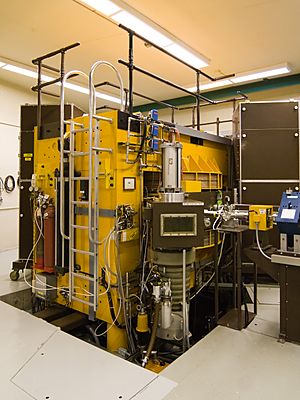Cyclotron facts for kids
A cyclotron is a special machine called a particle accelerator. It was invented by Ernest Lawrence in 1930 at the University of California, Berkeley. Its job is to make tiny charged particles, like parts of atoms, go really, really fast. It does this by spinning them around in a circle.
The first cyclotrons were quite small, about the size of your hand. Today, some of these circular accelerators can be as wide as a whole city! They are used for many important things, like making medicines and studying tiny particles.
Contents
How a Cyclotron Works
Cyclotrons use two main forces: magnetic fields and electric fields. Imagine a strong magnet that creates a steady magnetic field. Inside this field, there are two D-shaped metal plates, which people call "dees." These dees are hollow and face each other, with a small gap in between.
Here's how it works:
- First, charged particles are put into the center of the cyclotron.
- A strong magnetic field pushes these particles, making them move in a curved path.
- An electric field is turned on and off very quickly in the gap between the dees.
- When a particle crosses the gap, the electric field gives it a push, making it go faster.
- As the particle speeds up, the magnetic field makes it move in a wider circle.
- Just as the particle finishes half a circle and comes back to the gap, the electric field quickly reverses. This gives the particle another push, making it go even faster.
- This process repeats many times. The particles keep spiraling outwards, getting faster and faster with each turn.
- Finally, when the particles reach a very high speed, they exit the cyclotron through a special port.
This clever design allows cyclotrons to accelerate particles to incredible speeds.
The Cyclotron's Beat
The electric field in a cyclotron has to switch direction at just the right time. It's like pushing a swing: you have to push it when it's at the right spot to make it go higher. For a cyclotron, this "right time" is always the same, no matter how wide the particle's circle gets.
This steady timing is called the "cyclotron frequency". Because the timing is constant, the cyclotron can keep accelerating the particles. This works until the particles get so fast that they start to become "relativistic," meaning they are moving close to the speed of light.
What Cyclotrons Are Used For
Cyclotrons are very useful machines in science and medicine.
- Medical Uses: They help create special radioactive materials used in hospitals. These materials can help doctors see inside the body or treat certain illnesses, like cancer.
- Research: Scientists use cyclotrons to study the smallest parts of matter. They can smash particles together to learn what happens and discover new things about the universe.
- Material Science: Cyclotrons can change the properties of materials, making them stronger or more useful for technology.
Cyclotrons are amazing tools that help us understand the world around us and improve our lives.
Images for kids
-
A drawing from Ernest Lawrence's 1934 patent for the cyclotron. It shows the D-shaped electrodes inside a flat vacuum chamber, placed between the two large poles of a magnet.
See also
 In Spanish: Ciclotrón para niños
In Spanish: Ciclotrón para niños






